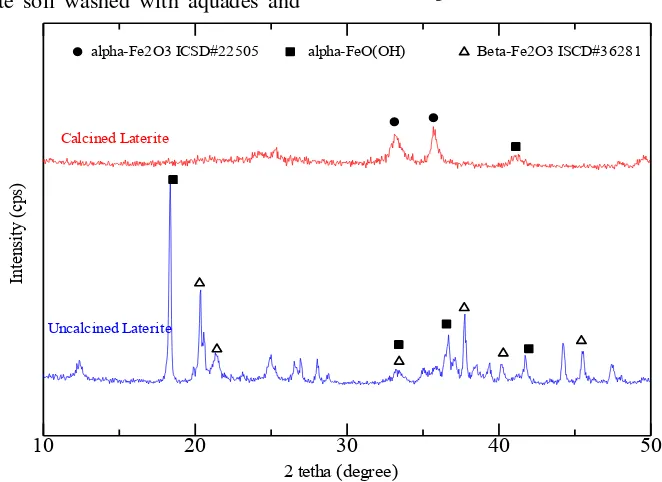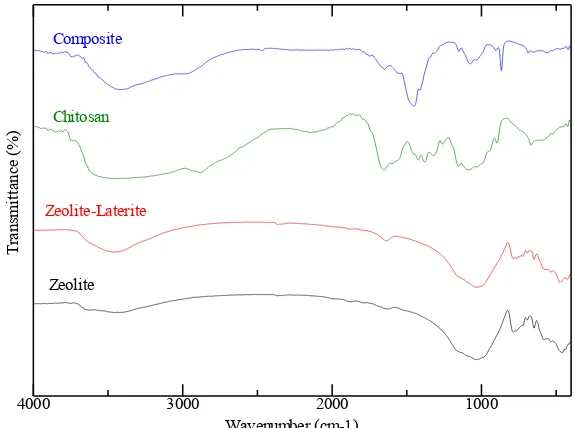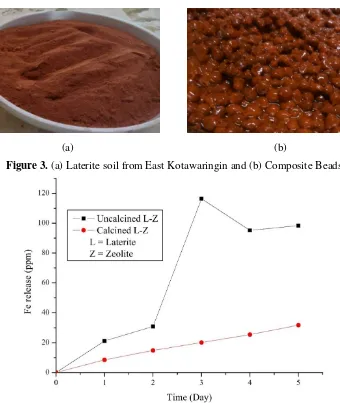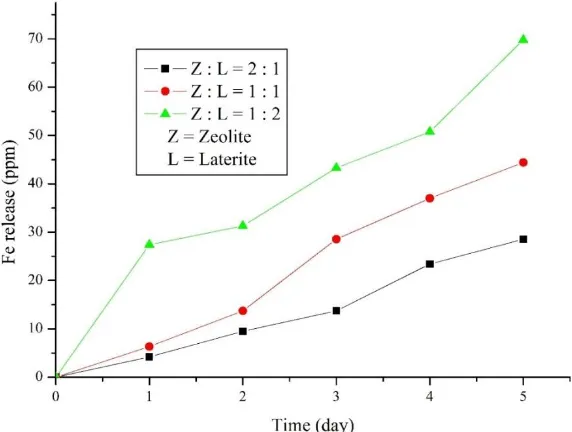Fabrication and Performance of Laterite East Kotawaringin-Zeolite/Chitosan Composite as Slow Release of Iron Fertilizer
Rendy Muhamad Iqbal1*, Sri Wardhani2, Darjito2, Karelius1
1
Department of Chemistry, Faculty of Science, University of Palangka Raya, Palangka Raya, Indonesia 2
Department of Chemistry, Faculty of Mathematics and Natural Science, Brawijaya University, Malang, Indonesia
*email: rendiqbale@gmail.com
Received September 16; 2018; Accepted November 29; 2018; Available online December 8, 2018
ABSTRACT
Laterite soil is one of natural resources in East Kotawaringin regency, Central Kalimantan, Indonesia, which contains high element of Fe. Fe is one of micronutrients that is needed for plant in slight amount. This study aims to determine the effect of chitosan composition and composition of zeolite : laterite on the release of Fe activities from synthesized fertilizers result. Laterite is characterized by using XRF and XRD. Slow release iron fertilizer is synthesized by eliciting laterite to zeolite matrix. Then, It is stirred into chitosan gel with concentration of 2, 2.6, and 2.8 % for 30 minutes. After Zeolite - laterite - chitosan has been homogenized, then it is dropped into 0.4 M NaOH to form beads. Then testing the release of Fe with the batch method in distilled water. The result showed that the laterite soil is amorphous form, and Fe content reached 80.25 % . The higher the concentration of chitosan which is used , then more Fe is released from fertilizer. Whereas if the amount of zeolite is greater, the slower the release of Fe will be.
Keywords: laterite, slow release, zeolite, chitosan, composite
INTRODUCTION
The formation of mineral by nature obtained many type of rocks such as metamorph, bauxite, sediment, pyroclastic, and laterite. Many places in Indonesia that the soil contained laterite mineral and Indonesia was the second largest country which has laterite content in those soil. Primary compound of laterite was iron, aluminium, and silica (Prasetiyo, 2008). The highest amount of iron in laterite could utilize to fulfilled micronutrients for plants. As micronutrient, iron has function as catalyst for synthesis of chlorophyll and helping transport system. The amount of iron which needed by plants was 100 mg/L (ppm) per day, but it's depend on type and age of their.
Some case about iron deficiency was found in many places in Indonesia such as Sulawesi and Nusa Tenggara. If the supply of iron was not good enough for the plant, it caused chlorosis disease, while if the plants have excess of iron nutrition that it will caused toxic. So that required effective way to meet the needs of the plant with a slow release system. The advantages fertilizer with slow release system were releasing of nutrient can be controlled and the lifetime of fertilizer will be longer (Kottegoda, Munaweera, Madusanka, & Karunaratne, 2011; Yao, Gao,
Chen, & Yang, 2013). Kottegoda et al. reported that the use of hydroxyapatite as material to controlled of micronutrient releasing (Kottegoda et al., 2011), Azeem et al reported that the some technique based sulfur, polymer, superabsorbent/water retention, and bio-composite based coating materials (Azeem, Kushaari, Man, Basit, & Thanh, 2014).
binder also has function as encapsulation and it's very good to controlled amount of micronutrient releasing (Rashidzadeh, Olad, Salari, & Reyhanitabar, 2014).
Some type polymer as well as biopolymer can be used to controlled amount of micronutrient release such as alginate, polysulfone, chitin, and chitosan. Chitosan is very famous biopolymer which is used by many researchers in the world for many applications, because it's very easy to isolated from animal-like shrimp shells (Phuc et al., 2016).
In this paper will explain our effort to utilize laterite soil from East Kotawaringin as source of iron which is combined with natural zeolite and chitosan to fabricated slow-release material.
EXPERIMENTAL SECTION
Chemical and Instrumentation
The materials are laterite soil from East Kotawaringin, natural zeolite from Turen, chitosan, NaOH, acetic acid, NH4SCN, HCl,
and HNO3. Instrumentation that used in this
research such as FTIR spectrophotometer (Shimadzu FTIR QP89500, sample was analyzed using KBr plate), XRD, XRF Panalytical MiniPAL 4, and spectrophoto-meter UV-Vis.
Pretreatment of laterite soil and natural zeolite
Laterite soil washed with aquades and
drying into oven at 110 °C for 2 h. Then, it grinded until forming softer powder and sieving using particular siever (size = 105 microns). After that, the powder of laterite soil calcined at 500 °C for 5 h. Laterite characterized by XRD and XRF. For zeolite pretreatment, the first step is zeolite activation. Natural zeolite washed with aquades and drying into the oven at 110 °C for 2 h. Then, it immersion into HCl 0.4 M and stirred for 15 minutes. After that, filtrate and residue separated by filtration and residue washed with aquades until the pH = 7. The last step, zeolite calcined at 500 °C for 5 h. The zeolite that used in this works was taken from Turen, and Difractogram of zeolite has been reported by Wardhani, Rahman, Purwonugroho, & Tjahjanto (2016).
Fabrication of Laterite East Kotawaringin-Zeolite/Chitosan Composite
The first step of composite fabrication was impregnated laterite into zeolite by mixing them into methanol and it stirred for 5 h. Then laterite-zeolite calcined at 500 °C for 5 h, then laterite-zeolite calcined and uncalcined used to fabricated the composite. 10 g of calcined and uncalcined laterite-zeolite mixed with chitosan gel 2 % and stirred them for 30 minutes (to form dope solution). After that, the dope solution was cast to form beads and immersion them into NaOH 0.4 M. Chitosan gel made by mixing chitosan powder with acetic acid 1%.
Figure 1.
XRD pattern of laterite soil from East Kotawaringin
10 20 30 40 50
2 tetha (degree)
In
te
n
si
ty
(
cp
s)
Uncalcined Laterite Calcined Laterite
The second optimation in this study is the effect of chitosan concentration, similar to the above procedure. The calcined laterite-zeolite mixed into chitosan gel with different concentration (2, 2.6, and 2.8%), then it cast to form beads. The third optimation is the effect of zeolite and laterite ratio, the dope solution was made by mixing laterite-zeolite with different ratio 2:1, 1:1, and 1:2 into chitosan gel 2%. The casting process was similar with the above procedure. The composite characterized by FTIR.
Fe release of each composite was tested by immersion of 3 g composite into aquades 100 mL for 5 days. Every 24 h, the sample was measured by spectrophotometer UV-Vis using NH4SCN as a complexing agent at 461
nm.
RESULTS AND DISCUSSION
Characterization of Laterite soil from East Kotawaringin
Laterite is characterized using X-ray Fluorescence (XRF), XRF result represents the highest compound of laterite East Kotawaringin is iron (Table 1). It was well-known that the main compound of laterite is iron, but the percentage of iron from one place and another place was different. It influenced by geographical activity in their place. Table 1. XRF result of laterite soil from East Kotawaringin
Laterite also characterized by X-Ray Diffraction (XRD) to determine crystal structure. As can be seen in Figure 1, XRD
appear which indicated the crystal structure of hematite and goethite was broke due to high temperature (Jozwiak, Kaczmarek, Maniecki, Ignaczak, & Maniukiewicz, 2007; Mandal & Axel, 2008). –OH from goethite was lose structure can't break completely at 500 °C, the higher temperature was possible to change completely from crystaline to amorphous phase. The advantages using amorphous phase for slow release fertilizer was iron will easily to release and the rate of release can be controlled using polymer binder and porous support material such as chitosan and natural zeolite that using in this work.
FTIR Characterization
The functional group that containing into laterite, zeolite, chitosan, and composite was determined by FTIR. The result was shown in Figure 2, the broad peak on 3300-3600 cm-1 caused overlapping of –OH and – NH2 vibration for chitosan and composite
spectrum. For zeolite and zeolite-laterite spectrum also appear –OH vibration which indicated –OH from α-FeOOH and zeolite clinoptilolite-mordenite structure. The wavenumber around 2900 cm-1 exhibit CHsp3 from the composite structure. Then, at 1600-1750 cm-1 represent –OH bending from zeolite and composite, in those wavenumbers also
As can be seen from Table 2, calcining process of zeolite-laterite influenced on the intensity of their functional groups. Decreasing of intensity exhibit the bonding of functional groups of zeolite-laterite was stronger, so the vibration of zeolite-laterite molecules was more difficult to vibrating when contacted with an infrared beam. For composite spectrum appear of –NH2
Figure 2. FTIR spectrum of zeolite, zeolite-laterite, chitosan, and composite
Table 2. Interpretation of FTIR Spectrum
Functional Group Zeolite (cm-1)
Performance test of slow release of iron from composite beads using batch methods, and everyday the sample was measured using spectrophotometer UV-Vis and NH4SCN as a
complexing agent. Figure 3 showed the image of laterite soil and composite. The first parameter which tested in this works is the effect of zeolite-laterite calcination on release performance. Uncalcined zeolite-laterite (UZL) has the faster release if compared with calcined zeolite-laterite (CZL), it was shown by the higher amount of Fe which measuring. The increasing release of iron for UZL significantly increased from second to the third day, while for CZL was constantly increased from start tested until the fifth day. This data showed that releasing iron from composite has similar
(a) (b)
Figure 3. (a) Laterite soil from East Kotawaringin and (b) Composite Beads
Figure 4. Effect of calcine process on Fe release
Because the release performance examine using the batch method, the higher amount of iron into the water might interact with composite if their amount too high.
The second optimation in this work is the effect of chitosan concentration, chitosan has function as polymer binder and leads to releasing of iron be slower. As explains that chitosan interacted with water and it will release the iron from composite, the higher concentration of chitosan made the releasing of iron to be faster. It caused the swelling of composite due to an interaction of chitosan and water, so the higher concentration of chitosan leads to increasing hydrophilicity properties of the composite which affects on releasing iron from composite. The higher hydrophilicity caused diffusion of water can be easier and iron would dissolve or released into water.
As can be seen in Figure 5 which represent the effect of chitosan concentration
on releasing performance, the concentration chitosan 2% exhibit the slower releasing of iron, while the higher chitosan concentration leads the releasing of iron was faster. Release performance of composite from first to the third day was unconstantly amount of iron which releasing, while after third-day testing, the increasing amount of iron was constant. It is caused the composite had saturated by water molecule and it leads releasing of iron being constant.
Figure 5. Effect of chitosan concentration on Fe release
Figure 6. Effect of zeolite and laterite ratio on Fe release
While the higher amount of laterite will increase releasing performance of iron from composite due to laterite was not completely impregnated into zeolite's pore. Effect of zeolite and laterite ratio is shown in Figure 6, releasing iron from first to the fifth day has a similar trend of all ratio. The longer time of testing made increase the amount of iron. Zeolite : Laterite with 2 : 1 ratio has slower performance, while Zeolite : Laterite = 1 : 2 has faster-releasing performance.
CONCLUSION
The composite which formed by Laterite East Kotawaringin-Zeolite/Chitosan was
success-fully synthesized as slow release of iron fertilizer. Based on XRF result, the amount of iron into laterite reach up to 80% and it is very promising as the iron source. It was supported by XRD pattern which represents that characteristic peak of goethite and hematite. Then, the performance test of slow release exhibit the higher the concentration of chitosan which is used, then more Fe is released from fertilizer. Whereas if the amount of zeolite is greater, the slower the release of Fe will be.
ACKNOWLEDGEMENT
dan Anggaran Daerah (DPKAD)” of East Kotawaringin regency for financial support and Inorganic Chemistry’s Laboratory of Brawijaya University for providing research facilities.
REFERENCES
Azeem, B., Kushaari, K., Man, Z. B., Basit, A., & Thanh, T. H. (2014). Review on materials & methods to produce controlled release coated urea fertilizer. Journal of Controlled Release, 181(1), 11–21.
Cairo, P. C., Armas, J. M. De, Artiles, P. T., Martin, B. D., Carrazana, R. J., & Lopez, O. R. (2017). Effects of zeolite and organic fertilizers on soil quality and yield of sugarcane. Australian Journal of Crop Science, 11(06), 733–738.
Hartanto, D., Iqbal, R. M., Fansuri, H., Iryani, A., Shahbihi, W. E., & Santoso, E. (2017). Effect of H2O/SiO2 molar ratio
on direct synthesis of ZSM-5 from Bangka’s kaolin without pretreatment. Malaysian Journal of Fundamental and Applied Sciences, 13(4), 817–820. Iqbal, R. M., Nurherdiana, S. D., Hartanto, D.,
Othman, M. H. D., & Fansuri, H. (2018).
Morphological control of
La0.7Sr0.3Co0.2Fe 0.8O3-δ and
La0.7Sr0.3MnO3-δ catalytic membrane
using PEG-H2O additive. In IOP
Conference Series: Materials Science
and Engineering, (Vol. 348, p. 012008).
IOP Publishing
Jozwiak, W. K., Kaczmarek, E., Maniecki, T. P., Ignaczak, W., & Maniukiewicz, W. (2007). Reduction behavior of iron oxides in hydrogen and carbon monoxide atmospheres. Applied Catalysis A: General, 326(1), 17–27. Koinuma, H., & Takeuchi, I. (2004).
Combinatorial solid-state chemistry of inorganic materials. Nature Materials, 3(7), 429–438.
Kottegoda, N., Munaweera, I., Madusanka, N., & Karunaratne, V. (2011). A green
slow-release fertilizer composition based on urea-modified hydroxyapatite nanoparticles encapsulated wood. Current Science, 101(1), 73–78. Chitosan Hydrogel for Wound Healing Application. International Journal of Polymer Science, 2016.
Piluharto, B., Suendo, V., & Maulida, I. (2017). Composite Beads Of Chitosan/Bentonite As A Matrix For Phosphate Fertilizer Controlled-Release. Journal of Chemical Technology and Metallurgy, 52, 1027–1031.
Prasetiyo, P. (2008). Utilizing Indonesia's Nickel Ore Potential in the Present and Future. Metalurgi, 23(I).
Rashidzadeh, A., Olad, A., Salari, D., & Reyhanitabar, A. (2014). On the preparation and swelling properties of hydrogel nanocomposite based on Sodium alginate- g -Poly ( acrylic acid- co -acrylamide )/ Clinoptilolite and its application as slow release fertilizer.
Journal Polymer Resource, 21, 344.
Wardhani, S., Rahman, M. F., Purwonugroho, D., & Tjahjanto, R. T. (2016). Photocatalytic Degradation of Methylene Blue Using TiO2 - Natural
Zeolite as A Photocatalyst. Journal Pure
and Applied Chemistry Research, 5, 19–
26.
Yao, Y., Gao, B., Chen, J., & Yang, L. (2013). Engineered Biochar Reclaiming Phosphate from Aqueous Solutions: Mechanisms and Potential Application as a Slow-Release Fertilizer.
Environmental Science and Technology,



